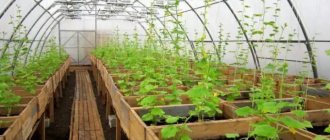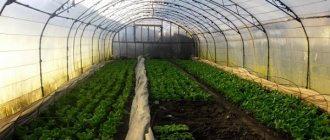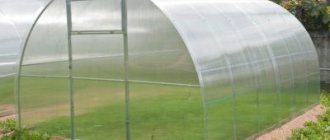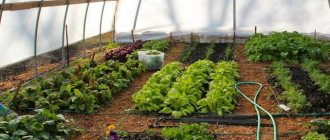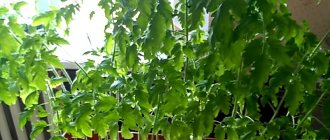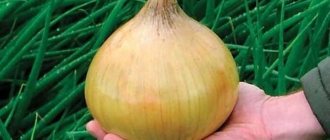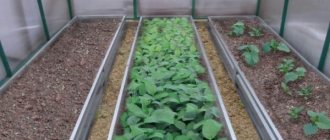In terms of its beneficial and taste qualities, radishes grown in a greenhouse are not inferior to vegetables from open ground. The cold-resistant crop allows you to get the first harvest of healthy products in the very early spring.
Radishes belong to the Cruciferous family and grow in annual and biennial crops. European varieties of vegetables that form small root crops weighing 10-20 g are suitable for growing indoors. Radishes can have a round or elongated shape and different ripening periods. For planting in a greenhouse in which heating is not provided, choose an early variety intended for cultivation in protected ground. Radish varieties for greenhouses and greenhouses are more resistant to stemming and shading.
Nuances for other seasons
Radishes can also be planted in summer . But long daylight hours will promote the formation of arrows, flowering and the active development of tops, and not the formation and development of fruits. In this case, it is necessary to cover the radishes with a dark cloth (not film, to avoid overheating), limiting the flow of light to the crop to 8-10 hours a day.
For summer planting, it is also necessary to use weak-shooting special varieties and hybrids such as White Nights, Champion, Virovsky Bely, Zlata, Detsky F1 and others. There are also late-ripening varieties for planting in August. They are not stored and are intended for quick consumption.
There is pre-winter sowing of radishes, which is carried out in November in a specially prepared bed in early autumn. However, it is the greenhouse planting of radishes in early spring that provides the most abundant and high-quality early harvest, the fruits of which are perfectly stored in plastic bags in the refrigerator for 3-4 weeks.
The best productive varieties
High-yielding varieties are especially popular among entrepreneurs. Selling delicious crispy radishes can bring in good income. And the more root crops the selected variety produces, the greater the profit you can make.
Greenhouse cultivation as a bonus gives quick results and increases yield.
Table 3. The best varieties of radishes with increased yield
| Variety | Maturation | Description |
| "Deca" | 21-25 days | Medium-sized fruits (up to 13 g). They have a red color and a snow-white core. The fruit is smooth with a blunt rounded end. Productivity – 3.8 kg/1 sq. m. |
| "Celeste F1" | 19-25 days | Radishes are large, weighing up to 30 grams. Rich white pulp with red skin. The variety is able to actively develop in conditions of short daylight hours and in unlit areas. Resistant to shoots and pests. The harvest yields 3.5 kg/1 sq. m. |
| "Champion" | 23-31 days | The root crops are large, reaching a weight of 25 grams. They have a round shape and a rich scarlet hue. Juicy pulp without unnecessary bitterness. The final yield is 3.9 kg/1 sq. m. |
| "Firstborn F1" | 17-19 days | Hybrid with very large fruits (up to 35 g). The variety is not prone to cracking. The taste is sweetish, the flesh is rich. Yields 3.5 kg of radish per square meter. |
| "Beauty" | 23-25 days | The variety performs well in low light. The radish is completely round, with transparent whitish flesh and a red skin. From a square meter of bed you can get 2.5 kg of fruit. |
When to start sowing seeds?
Radishes can be planted in protected soil as soon as the sun warms up and the temperature is close to zero.
Depending on the climate zone, in Russia you can plant radishes in a greenhouse as early as February – March .
Of course, in Siberia, where spring begins later than in central Russia, the time for planting radishes in a greenhouse comes in early - mid-April, depending on the time of arrival of climatic spring, which in this extended region begins the further north, the later.
In the Urals, the time for planting radishes in a greenhouse begins in late March - early April. In the central part of Russia - mid-late March.
This is the earliest time for planting to begin. However, they have already been tested by specialists and amateurs. Both claim that radish shoots can withstand temperatures up to – 1, and adult plants – up to – 5 degrees .
Diseases
Radishes can suffer from downy mildew, fomosis, black leg, white and gray rot, alternaria, and mucous bacteriosis. As a preventative measure, it makes sense to warm the seeds for 20 minutes at a temperature of 48-49° before planting, and then cool them in cold water for 2-3 minutes. Before sowing, the soil can be treated with potassium permanganate (1.5 g per 5 liters of water) or copper sulfate (1-2 tbsp per 10 liters).
It is necessary to avoid thickening the plantings, and also, if necessary, ventilate the greenhouse to get rid of dampness. Recommended relative humidity is 65-70%. At 80% and above, the risk of disease increases.
Difference between early and late spring
For early planting, early-ripening and early-ripening varieties are used. In this case, large seeds are best suited. Ideally, they should be selected by sifting through a sieve with 2.5 mm mesh.
Radishes are plants in which long daylight hours cause bolting and flowering of the tops. In this case, the root crop becomes of poor quality. Therefore, for each planting time, including for planting in early and late spring, it is necessary to select the appropriate varieties.
For planting in late spring, which also occurs differently in different zones (for example, in the north of the Siberian part of Russia - this is the end of May - beginning of June), the variety Rose-red with a white tip, Half-red - half-white 471, Würzburgsky 59, Ledyanaya is suitable for planting. Icicle, Saxa, Novinka, Red Giant and similar varieties. Planting is done in open ground .
Planting radishes in a polycarbonate greenhouse according to the lunar calendar 2022
As you can see, planting radishes is a very simple operation that does not require special knowledge. But as in any business, there are nuances and subtleties. One of these features that allows you to grow a larger harvest is planting according to the 2022 lunar calendar. It can be treated differently, but those who plant on favorable days experience better results. Try it too.
Let's look at the calendar and determine favorable days for planting:
- February: 20-24
- March: 20-25
- April: 19-24
- May: 18-21
If you pay attention, you will see that favorable days fall on the waning moon. This is the basic rule of the lunar calendar for gardeners and gardeners. Everything that grows underground is planted on the waning moon, and everything that grows above the ground is planted on the waxing moon. Remember this, look at the calendar and choose the most favorable days for you.
Growing without heating, in a regular greenhouse
It must be said that early cultivation of radishes in February - March is possible in a heated greenhouse. Stationary, well-lit and sun-warmed greenhouses are ideal for early planting. But you can grow an excellent early harvest in a regular greenhouse if you organize so-called “warm” beds with bioheating.
To do this, unrotted, fresh manure is placed under the plantings. If the manure is dry, it should be soaked in water . For this purpose, horse hay in its pure form, and cow and goat hay mixed with straw 1:1 are suitable. If there is no manure, then ordinary hay, wood shavings, autumn leaves, and, in principle, any dead wood are placed under the beds.
It is compacted with a layer of up to 30 cm, then poured with boiling water from a weak solution of potassium permanganate, covered tightly and allowed to steam. Then they are covered with soil for planting. Such arrangement of greenhouse beds will ensure an excellent harvest of radishes in the earliest possible time and without any heating, especially in areas with a later onset of heat, such as the Northern Urals and Siberia.
Reference! In the European part of Russia, it is quite enough to properly prepare the soil for planting. In case of frost, the soil in the greenhouse is sprinkled with water, and the steam formed under the dome of the greenhouse will prevent the plants from freezing.
Watering
Until the seedlings emerge, the soil is only sprinkled with water, since with normal watering the seeds may go deep and not germinate. After sprouts appear, water the radishes moderately, but do not allow the soil to dry out. When real leaves appear, water it more often. Usually once every 2-4 days is enough. The soil should be moist to a depth of 15-25 cm.
After watering, it is sometimes recommended to loosen the soil, but this must be done carefully so as not to injure weak shoots. If the planting area is small, this can be done using miniature devices - sticks or cloves.
When radishes form roots, it is very important to maintain the necessary soil moisture. If the soil has been dry for several days, the damage cannot be corrected even with subsequent regular watering. Lack of moisture makes root vegetables rough, bitter, and empty. Due to irregular watering, they may crack. Always moderately moist soil is a necessary condition for growing radishes.
Step-by-step instructions on how to grow radishes
So, for a good quality radish harvest in early spring, we need to choose varieties and prepare seeds.
Variety selection
It is recommended to plant several varieties of radishes at once to determine which one will give the right result for you. So, early-ripening and early-ripening varieties that have proven themselves well when planted early :
- Molniya F1, Dabel F1, Celeste F1, Cherriet F1, Rondar F1, Azhur F1, 18 days – crispy radish without bitterness.
- Tarzan F1 and Caspar F1 give abundant harvests.
- Rhodes and Riesenbuter (also known as Butter Giant) produce large red fruits.
- More expensive varieties are hybrids Masterred, Estarred.
- They have proven themselves well and are loved by gardeners - Early Red, Parat, White Zephyr, Saksa, Alyoshka F1, Chara, French Breakfast, Ivolga17 and others.
Read more about radish varieties intended for growing in a greenhouse here.
Buying seeds
Radish seeds can be bought in trusted online stores or branded seed stores throughout Russia. For example, Partner company stores are in more than 30 cities in different regions of Russia, and the AGRO online store offers prompt delivery throughout Russia.
Price for 1 g. seeds range from 25 rubles and above depending on the variety and store.
Preparing for sowing
To plant in a greenhouse, the seeds should be sifted through a sieve, selecting the largest ones - from 2 mm. Leave the rest for planting in open ground. Then they are soaked between layers of gauze for 2-3 days, then when the seeds have produced tiny bores, they are treated with a weak solution of manganese and soaked in a growth stimulator according to the instructions.
How to plant correctly?
There are several schemes for planting radishes in a greenhouse.:
- One of them is to make furrows 5 cm deep, keeping the distance of the seeds in the bed at 4 cm. At the same time, the planting depth is 1 – 2 cm.
- There is a way to mark holes by pressing industrial egg cells into the ground. They are also able to optimally organize the planting pattern.
- Planting methods in special cassettes or cups are also popular.
Round varieties of radishes require a soil layer of 15 cm, and long ones - from 20 cm. The soil for planting should be loose, well permeable to moisture. Some gardeners achieve excellent harvests with a minimum of fertilizer used.
Attention! Radishes do not like acidic soils, so they should be alkalized, for example, using ash.
We invite you to watch a video about sowing radishes in a greenhouse in the spring:
On our website you can find materials about growing radishes in a polycarbonate greenhouse, planting this vegetable in April and sowing it in early spring, as well as about greenhouse varieties.
Radish varieties without bolting tendency
For some gardeners, radishes constantly go to arrows. Instead of a juicy root crop, what remains is an elongated tip, which certainly cannot replace a bountiful harvest of radishes. This usually occurs due to lack of light or other reasons. But there are varieties that are not prone to bolting.
Table 5. Radishes resistant to bolt formation
| Variety | Maturation | Description |
| "Presto" | 15-17 days | An excellent option for sale, as the fruits look great and ripen quickly. The pulp is juicy. |
| "Globe F1" | 16-18 days | Early ripening hybrid. Produces fruits weighing up to 15 grams. The harvest is quite voluminous - from 1.5 kg. per square meter of ridge. |
| "Vera MS" | 31-36 days | Each radish weighs approximately 25 grams. The variety is not prone to cracking and shoots growing. The harvest yields up to 2 kg. per square meter. It is characterized by productivity and pleasant taste. |
| "Ilka" | 26-29 days | The variety does not shoot shoots and is not susceptible to diseases. The fruits are delicate in taste, with a mild pungency. Radishes are round in shape and resistant to flabby. |
| "Zlata" | 19-25 days | A very popular variety of early ripening radish. The plant is not prone to shoots and tolerates drought well. The fruits are an unusual yellow color for radishes, with juicy white pulp. It looks attractive and withstands long transportation well. |
| "Duro" | 27-28 days | Large radishes weighing up to 40 grams. Among the advantages of the variety are resistance to the formation of arrows, immunity to attack by pests and a sweet taste. |
| "Mercado" | 26-30 days | A product of breeders from Japan, which is not prone to flowering. The fruits are red, round, weighing up to 22 grams. The core has a dense structure, snow-white and sweetish. |
Important! Cucumbers are a good predecessor for radishes. These two cultures suffer from different diseases, so they will not harm each other.
Care
Caring for young plants is quite simple:
- They need to be thinned out in time to ensure a distance of at least 4-5 cm, loosened and watered 1-2 times a day.
- The temperature required to maintain the growth of young plants ranges from 10 to 20 degrees Celsius.
The first days after the sprouts have hatched, it is better to provide 6-8 degrees of heat to avoid stretching of the seedlings. After 4 days of growth, the optimal temperature becomes from 12 to 18 degrees. At night, the temperature in the greenhouse can drop to 10 degrees. However, the plants will not die even in case of frost down to -5 degrees. - Young plants should be fed twice during growth with nitrogen fertilizers (20 g per 1 m²). Humus sprinkled on top of the beds will prevent them from drying out and will also provide the necessary fertilizing. Read more about how to feed a plant after germination in a greenhouse and in open ground here.
How to properly plant radishes in a polycarbonate greenhouse on snow
I am often asked if it is possible to plant radishes in the snow and how to do it. I’ll say right away - it’s possible, the root crop we plant is cold-resistant and can tolerate shallow frosts. Let’s not ask the question why to do this, let’s try to answer how to do it.
The technology is as follows:
In the greenhouse, prepare a bed, apply a layer of snow 2-3 cm thick on it.
Place one radish seed on the snow, 5 cm apart from each other, and cover it with glass on top.
Snow is needed to moisten the soil and harden the seeds. The melted snow will moisten the soil, and the glass on top will not allow the moisture to evaporate.
When sprouts appear, remove the glass. I also recommend adding potassium-phosphorus fertilizers to the bed at the rate of 15 g per 1 m² before applying snow.
That's all. Try it and write reviews.
Harvesting and storage
When the fruits are 2 cm in diameter, you can begin harvesting . It is done in three steps, collecting the largest ones. Store early radishes in a cool, dark place in slightly opened plastic bags.
We invite you to watch a video about harvesting and storing radishes:
Find out more about how long radishes grow in a greenhouse and when the first harvest appears in this material.
Why doesn’t it grow, disappears into the tops, doesn’t set, or cracks?
- The radishes are very elongated. The main reason why radishes suddenly stretched out is the lack of light. Also, the cause of this problem may be the density of the seedlings.
- The radishes are cracking. This occurs when there is a lack of moisture, especially if the plant was moistened after a drought. Cracks in the root crop occur due to an increased amount of nitrogen compounds.
- The radishes go into the tops. The most common reason is late sowing. The most inappropriate time is summer. The following reasons for the appearance of tops are also possible:
- heavy soil;
- poor loosening;
- no thinning of radishes.
- Radishes don't set. Main causes of the problem:
- acidic or compressed soil;
- planting thickening;
- heatwave;
- oversaturation with fertilizers.
What difficulties might there be?
All the difficulties associated with maintaining the optimal temperature in the greenhouse are easily overcome by the root crop itself, which is extremely unpretentious and is ready to please the gardener with an excellent harvest at any time of the year.
The main thing for successful cultivation of radishes is loose, prepared soil and compliance with the length of daylight hours. The latter is easily observed in the case of early spring planting in a greenhouse. Try, grow and get a vitamin boost from early spring to late autumn!
When and at what temperature can radishes be planted in a greenhouse?
It will not be an exaggeration if I say that this vegetable can be planted from March to October. But, as in any case, there are exceptions. The fact is that radishes are a short-day root crop. In order for it to grow well, it needs no more than 10-11 hours of daylight. He also loves cool and sunny weather.
That is why months such as June and July are completely unsuitable for him. Of course, it is possible to plant, but it is unlikely to harvest. It will all go into the arrow and color. You can try to darken it with opaque materials, but I have never tried this, so I don’t give advice. Try to avoid these two months from planting. The best months, again, are March, April and May. This is a time when there are no other vegetables yet, and radishes are the desired first-born on our table.
Culture compatibility table
Cruciferous crops grow happily next to many plants. Some of them are ideal for radishes, while others, on the contrary, do neither harm nor benefit. It is better not to plant root crops with third plants due to competition for light or water.
The radish compatibility table with crops is as follows:
| Perfect | Neutral | Undesirable |
| onion | pumpkin | White cabbage |
| dill | melon | chard |
| sorrel | watermelons | Chinese cabbage |
| carrot | garlic | fennel |
| parsley | zucchini | hyssop |
| salad | horseradish | |
| beet | daikon | |
| pepper | radish | |
| eggplant | turnip | |
| cucumbers | rhubarb | |
| tomatoes | sunflower | |
| potato | corn | |
| peas | ||
| beans | ||
| marigold | ||
| nasturtium | ||
| calendula | ||
| celery | ||
| parsnip |
Radishes are easy to grow. The main thing is to choose a suitable site for it and the right companions. They will have a beneficial effect on cruciferous crops, helping to increase productivity. Radish neighbors help root vegetables grow strong, juicy, and tasty.
Bad neighborhood
Despite the fact that radishes are compatible with almost all vegetables in the garden, there are crops that they do not like. And they respond to him in complete reciprocity. So, you should not plant next to radishes: fennel, rhubarb, hyssop. As noted above, cabbage, radishes, turnips, and other plants from the Cruciferous family should also be placed away from radish crops. If you don’t do this, you will get tired of fighting pests that fly from one garden bed to another in search of goodies.
